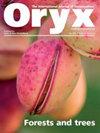关于建立跨岛树冠桥网络以支持马来西亚兰卡威岛灵长类动物运动的建议
IF 2.1
3区 环境科学与生态学
Q2 BIODIVERSITY CONSERVATION
引用次数: 0
摘要
交通和服务走廊的扩张对野生动物产生了许多有据可查的不利影响。然而,关于这一主题的研究很少被转化为减轻道路开发对灵长类动物栖息地破碎化的影响。树冠桥的建立已被证明是一种有效的保护措施。据我们所知,在文献中报道的已完成的灵长类树冠桥项目中,所有项目都试图减轻单一线性基础设施路线造成的影响。在这里,我们为在马来西亚兰卡威岛的道路上建立一个自然和人工树冠桥网络提供建议,通过确定合适的地点和适当的树种(包括总形榕和榕)、桥梁材料和安装后监测,减少道路死亡的几率,支持灵长类动物和其他树栖动物在岛上的活动。这个开创性的跨岛树冠桥网络的建立可以作为一个模型,增强马来西亚其他重要野生动物栖息地的连通性,这些栖息地受到线性基础设施碎片化的影响。我们已经开始与有关部门、合作伙伴和其他相关方进行讨论,重点是在2024年启动树冠桥网络的建设。本文章由计算机程序翻译,如有差异,请以英文原文为准。
Recommendations for the establishment of a trans-island canopy bridge network to support primate movement across Langkawi Island, Malaysia
The expansion of transportation and service corridors has numerous, well-documented adverse effects on wildlife. However, little research on this topic has been translated into mitigating the effects of habitat fragmentation caused by road development on primates. The establishment of canopy bridges has proven to be an effective conservation intervention. Of the completed primate canopy bridge projects reported in the literature, to our knowledge, all attempt to mitigate the impacts caused by singular, linear infrastructure routes. Here we provide recommendations for the establishment of a network of natural and artificial canopy bridges over roads throughout Langkawi Island, Malaysia, to reduce rates of roadkill and support the movement of primates and other arboreal animals across the island by identifying suitable sites and appropriate tree species to be planted (including Ficus racemosa and Ficus fistulosa ), bridge materials and post-installation monitoring. The establishment of this pioneering trans-island canopy bridge network could function as a model to enhance connectivity for arboreal animals in other important wildlife habitat sites in Malaysia and beyond that are affected by fragmentation from linear infrastructure. We have begun discussions with relevant authorities, partners and other pertinent parties, focusing on the initiation of construction of the canopy bridge network in 2024.
求助全文
通过发布文献求助,成功后即可免费获取论文全文。
去求助
来源期刊

Oryx
环境科学-生态学
CiteScore
5.30
自引率
7.40%
发文量
150
审稿时长
18-36 weeks
期刊介绍:
ORYX—THE INTERNATIONAL JOURNAL OF CONSERVATION, a quarterly journal from Fauna & Flora International, publishes research on biodiversity conservation, conservation policy and sustainable use, and the interactions of these matters with social, economic and political issues. The journal has a particular interest in material with the potential to improve conservation management and practice. Explore the map for details of published articles.
 求助内容:
求助内容: 应助结果提醒方式:
应助结果提醒方式:


